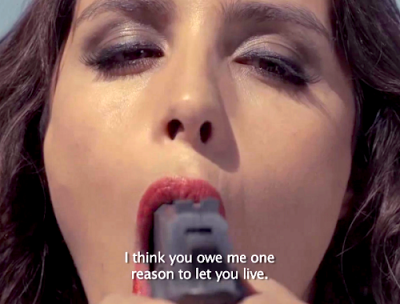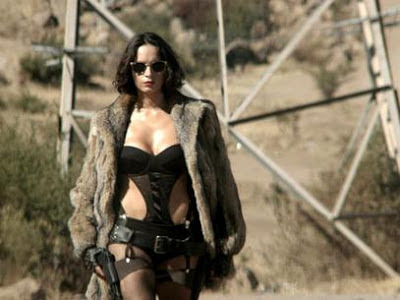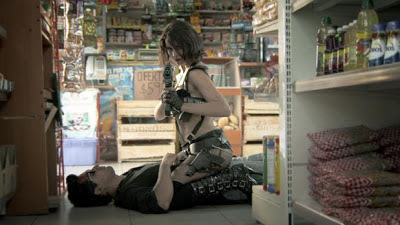 |
| Where do you go when the record is over? |
Although
it may seem dated and cheesy to some viewers today Saturday Night Fever
remains one of the most underrated examples of '70s pop-culture. It is
undoubtedly the quintessential dance flick and remains one of the most
entertaining films of all-time. Yet, behind all the music and
entertaining aura you are actually viewing a drama studying the American
class system and young rebellion. Though at times it is slightly
exaggerated, it still manages to capture a vast amount of authenticity
and ultimately the sights and sounds of the time.
Saturday Night
Fever follows self-proclaimed "dance king" Tony Manero (John Travolta)
and his love of dancing and the trials and tribulations of his life in
the Bronx. He soon meets an arrogant fellow dancer named Stephanie
Mangano (Karen Lynn Gorney). Quickly becoming attracted and influenced
by the women he starts questioning the way he lives his life.
The
film is not always upbeat and at times can be depressing, particularly
the scenes depicting peer-pressure. Although both have their
differences, both are very alike and ultimately want to be something
"big". There are also the elements of jealously, rivalry, religion,
rebellion, respect and racism added into the film. This captures the
realism of the time and with more accuracy and honesty than a lot of
films. Just take a look at the brief scene where Tony is on the tube,
this is an oddly poignant, effecting and compelling scene presenting
Tony's confused emotions.
 |
| Meet Tony Manero's gang. |
Saturday Night Fever still carries the
vibe, rhythm and atmosphere it did back in '77. It remains one of the
most influential films for both the film-world and pop-culture.
Infamously holding some of the greatest dance sequences ever committed
film; you can feel the energy, emotions, time and determination that
were spent perfecting the dance scenes to the finest detail. The
lighting is perfect at creating the "disco world", the set-piece of the
2001 Disco is one of the film's many iconic highlights.
John
Travolta dedicates himself to his dancing and character, fitting the
role with a graceful ease. The film goes into depth at studying
characters too, it shows how desperate everyone is to fit in and be able
to make an impressive image. The fantastic shots on character's feet
show the "strut" in their walk, representing their desire to maintain
their reputation of being "cool". All the characters want to be
something, while a lot of them will never add up to anything due to
their working-class backgrounds. There are a fair amount of American
social-comments scattered throughout the film and retaining a surprising
amount of intelligent value.
The gloriously groovy and funky
soundtrack is possibly the film's finest element. The music accompanies
the dance sequences with an amazing amount of memorably robust imagery.
The use of The Bee Gees' music is wonderful to listen to and also for
helping to create an ambiguous atmosphere of love, drugs and sex. The
shooting techniques in the disco are magnificent for filming the dance
scenes and fit perfectly alongside the other technical elements.
 |
| You should be dancing too! |
Saturday
Night Fever is a far more professional film than one might expect, it
has intelligence as well as entertainment, which is something that makes
a more than just admirable achievement. It is a truly remarkable
triumph and a film that deserves more appreciation than it gets.
42 facts you probably didn't know about the making of Saturday Night Fever.
1. John Travolta's sister Ann Travolta appears as the pizza lady, and his mother Helen Travolta appears as the woman for whom he gets the paint.
2. Norman Wexler's screenplay was adapted from the "non-fiction" magazine article written by Nik Cohn.
Years later, Cohn admitted that the story, supposedly a fact-based
account detailing the lives of Brooklyn teenagers in the early days of
the disco craze, was a complete fabrication.
3. Filming was frequently halted on the streets of New York City because teenage girl fans of John Travolta would scream when they saw him due to his popularity from the ABC show Welcome Back, Kotter.
4. In the city of Rio de Janeiro, Brazil, "maneiro" is a widely-used word,
meaning "cool", taken from the character name, Tony Manero.
5. One piece of music from the soundtrack, "Manhattan Skyline" by David Shire
became very popular as background instrumental music. It was been
played in movie trailers, promotional films and commercials. It's the
piece that Stephanie is dancing to when Tony invites her to coffee.
 |
| What can I do for you ma'am? |
6. Some VHS releases of this movie had the songs "Dr. Disco", "Disco Duck",
and "K-Jee" replaced with a generic disco song due to royalty disputes.
7. Fran Drescher confessed later she was not wearing underwear when she did her scene with Tony just before his big solo dance.
8. More than 40% of the cast made their feature debuts in this film including, Joseph Cali, Shelly Batt, Denny Dillon, Fran Drescher, Donald Gantry, Adrienne King, Ellen March, Bruce Ornstein, Paul Pape, Lisa Peluso, Donna Pescow, Ann Travolta and mother Helen Travolta (her only feature cameo).
9. Allan Carr designed the ad campaign for the film. It was so successful, that producer Robert Stigwood asked Carr to help him produce his next film, Grease.
10. The film was rated R when it was released in late 1977. The studio was
so eager to attract more young people to the film because they were
buying the soundtrack album, that the film was cut by a few minutes and
the shorter version was given a PG rating. The PG version was released
in 1978. Both versions were released on VHS but only the R rated version
was released on DVD.
 |
| Troubled family. |
11. An unedited version of "How Deep is Your Love" remains in the vaults. It
is featured when Tony walks aimlessly to the subway, and is riding over
to Stephanie's.
12. Jessica Lange, Kathleen Quinlan and Carrie Fisher were all considered for the role of Stephanie Mangano, Amy Irving was one of the finalists for the role.
13. John Travolta
originally wanted his disco suit to be black, until it was pointed out
that in the darkened disco, his co-star's red dress would make her
easier to see than him.
14. In Tony (John Travolta)'s bedroom there's a poster for Rocky, a film directed by John G. Avildsen. The sequel to this film, Staying Alive, was written and directed by the star of "Rocky", Sylvester Stallone. In fact, Avildsen was the original director of this film but was fired by producer Robert Stigwood shortly before principal photography began due to "creative differences". John Badham was approached to fill in at the last minute. Tony also has a poster for Serpico
on his wall. Avildsen was originally considered to direct that film as
well, but left the project due to "creative differences."
15. The only scene that does not feature John Travolta's feet is the one where he's comparing his shoe to the shoe in the store window.
 |
| Greedy little girl. |
16. The white polyester suit worn by John Travolta sold at auction for $145,000 and purchased by movie critic Gene Siskel.
17. John Travolta ran two miles a day and danced for three hours daily to get in shape for this film. In the end, he dropped 20 pounds.
18. Production had to be briefly halted so that John Travolta could attend the funeral of his girlfriend Diana Hyland.
19. Bobby's car is a 1964 Chevy Impala hardtop. While director John Badham
insisted on the Impala as Bobby's car, he was later told by
Brooklynites that they would only drive an old Cadillac - and never an
Impala. Each Impala (there were two used) was purchased by the film
company for $1200. The Impala hardtop (with no post) is difficult to
find today and will cost quite a bit more than the $1200 it did in 1977.
20. The soundtrack album sold over 20 million copies, and it was the top selling album in history until it was topped by Michael Jackson's Thriller six years later.
21. John Travolta had
worked hard on the "You Should Be Dancing" sequence and threatened to
quit the film when the studio suggested it should be shot in close up
instead of full-body.
 |
| Annete's madly in love with Tony. |
22. When they shot the first bridge scene, director John Badham kept secret from Donna Pescow
the fact that when 'the guys "fell off" the bridge they actually landed
on a platform a few feet below. Badham and the other actors didn't tell
her about the platform because they wanted a genuine look of horror and
anger on Annette's face when Tony, Double-J and Joey appeared to fall
off. Therefore Donna's reaction to them falling, and her facial
expressions turning from horror and shock to outright anger, were real,
and her next line, "YOU FUCKERS!", was not scripted.
23. When Tony's dad hit him in the back of the head the third time during
dinner, his retort of "Just watch the hair!" and then his complaint
about being hit on the hair after he had worked on it for so long was John Travolta's own reaction and not scripted, but since it was so in character for Tony Manero to say, it was left in.
24. The scene where Fran Drescher puts her hand on John Travolta's butt was not in the original script. Travolta and director John Badham thought that it would be something that a woman like Connie (Drescher's character) would do, however, so it was kept in.
25. After being shortened from "Tribal Rites of the New Saturday Night" (the
title of the New York Magazine article that inspired it), the working
title of the film was "Saturday Night". When The Bee Gees added a song to the soundtrack called "Night Fever", the word "Fever" was added to the film title. This is the second time a John Travolta project had the title altered due to a song (see trivia for Welcome Back, Kotter).
26. This was one of the very first films to utilize the Steadicam, a camera-stabilizing device invented by Garrett Brown (who would win a 1978 Oscar for his invention).
27. Five additional instrumental cues by David Shire
were recorded for the film: "Barracuda Hangout", "Tony and Stephanie",
"Near the Brooklyn Bridge", "Death on the Bridge", and "All Night
Train". However, only one was credited, and all remained unreleased.
 |
| Poor Annette! |
28. Originally, director John Badham
filmed the dance rehearsal sequence with Tony and Annette's characters
playing music in the background at the same time with the action and
dialogue; a form of production conduct not usually done. The song was
"Lowdown" by Boz Scaggs. However, after filming the scene, John Badham got word from Scaggs' people they did not want the song in the picture, and so the sequence was dubbed, with John Travolta and Donna Pescow recording their lines in a vocal booth, and in the end composer David Shire
orchestrated an instrumental piece for the sequence; ultimately the
song (the title still unknown to this day) was picked up by the National
Football Leagues, and used to open and close the Monday Night Football
program for over 20 years.
29. Two additional songs for the film ended up not being used. One was The Bee Gees singing their self-penned version of "If I Can't Have You", and Samantha Sang's
"Emotion" (which was recorded by Destiny's Child in 2001 - the song was
played on radio playlists after the September 11, 2001 terrorist
attacks).
30. The movie was originally called "Tribal Rites of the New Saturday
Night," the title of the New York Magazine article that inspired it. The
film's title was ultimately shortened to "Saturday Night," as a direct
reference to the fact that Tony (John Travolta) and his buddies inhabited 2001 Odyssey on Saturday nights. However, when The Bee Gees
submitted the soundtrack, one of the songs, "Night Fever", was thought
to embody the film's spirit better than the original. Director John Badham added the word "Saturday" and it replaced the original title.
 |
| You're too poor for me Tony, I can't give you a blowjob. |
 |
| You can't afford this hairy pussy Tony. |
31. The elevated subway line shown in the film, the West End line, is the same one used in the famous chase sequence in Contra el imperio de la droga.
32. Film critic Gene Siskel often referred to this as his favorite film. He saw it 17 times and at one time owned the famous "white suit".
33. This was the first mainstream Hollywood movie in which the term "blow job" was used.
34. Fran Drescher's film debut.
35. Independent film director Lloyd Kaufman nearly dropped out of the film as a production assistant when longtime friend and associate John G. Avildsen left the project.
36. The line "Can you dig it? I knew that you could," spoken at various
times by Tony and his friends was originated by Billy Crystal on a 1975
episode of Saturday Night Live and became a national catchphrase.
37. Filming was almost interrupted when a local mafia group tried to extort
protection from the crew. In fact, the nightclub where the film was shot
was hit with a small firebomb.
38. A group of Hasidic Jews, who were against the crew filming in their
neighborhood, tried to disrupt filming and even tried to turn over one
of the cars used in the production.
 |
| Tony finds the awful truth about life. |
39. Ray Liotta and David Caruso auditioned for the role of Joey.
40. The lighted wall and lighted floor at Odyssey 2001 were not actually at
the disco, but added in for the film. The "blinking light" effect on the
wall was created by covering the wall in tin foil and reflecting
blinking Christmas tree lights off of it.
41. Director John Badham
claims in the DVD commentary that for performing product placement of a
Trojan condom in one scene of the movie, he was given a lifetime supply -
and that he "donated" them all to someone else.
42. According to the DVD commentary, John Travolta
used two suits in the climax of the film, he had to switch suits
between takes because one would become heavily soaked with sweat and had
to be dried while he was wearing the other one for subsequent takes.
Overall, a great film that depicts the many aspects of human failure and how we, the regular people find ways to escape from our troubled lifes. I so recommend it to everyone but, be warned this isn't just a dance movie, it is the bitter testimony of dreamers that don't make it.
Here's the cool movie trailer and, I'd like to dedicate this review to my wife who loves this film as much as I love her:







































